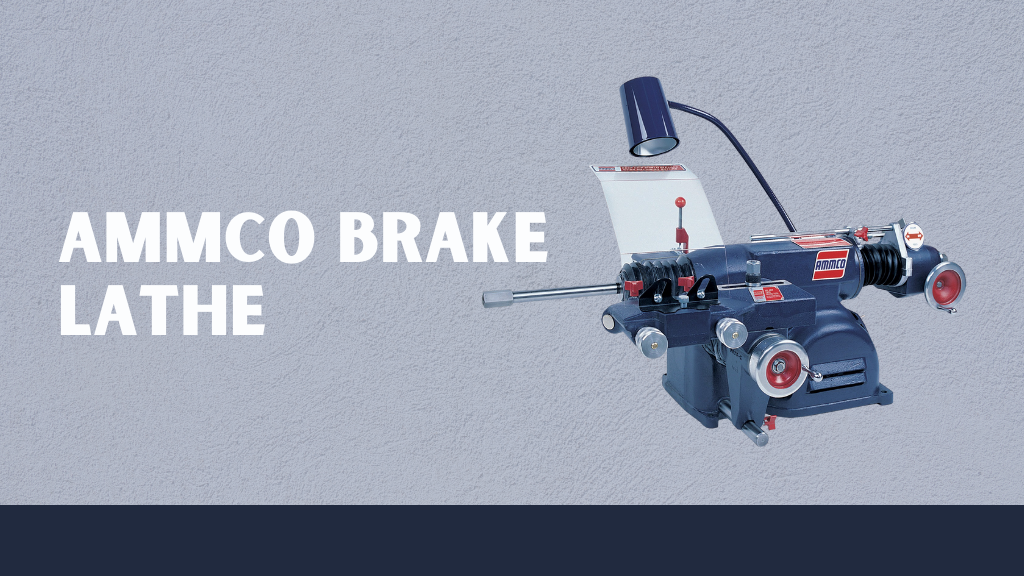The automotive repair industry relies heavily on precision tools that guarantee safety and efficiency. One such indispensable tool is the Ammco brake lathe. Known worldwide for its reliability and accuracy, it is a staple in professional garages, tire shops, and dealerships.
In this guide, you will learn everything about Ammco brake lathes, including how they work, why they are important, their features, maintenance tips, and insights from real-world use. If you are a professional mechanic, a shop owner, or simply someone researching the best brake service equipment, this detailed guide will help you make informed decisions.
What Is an Ammco Brake Lathe
An Ammco brake lathe is a machine specifically designed to resurface brake rotors and drums. Instead of replacing worn rotors and drums, mechanics can use this lathe to restore a smooth, flat surface that ensures proper brake performance. By machining the brake components back to manufacturer specifications, the tool improves braking efficiency and extends the lifespan of the parts.
Brake lathes are essential because even minor imperfections such as grooves, uneven wear, or warping can affect stopping power. The Ammco brand has been a leader in this field for decades, trusted by professionals who demand precision and durability.
History of Ammco Brake Lathes
Ammco, officially known as Automotive Maintenance Machinery Company, has been manufacturing automotive equipment since the mid-20th century. It quickly gained recognition as one of the top names in brake service tools.
- In the early years, Ammco focused on producing high-quality lathes for drums and rotors.
- During the 1960s and 70s, Ammco brake lathes became the industry standard in the United States.
- Over time, the company expanded its offerings, introducing innovative designs that improved operator safety, accuracy, and efficiency.
- Today, Ammco brake lathes are used in workshops across North America, Europe, and Asia.
The legacy of Ammco lies in its ability to maintain quality, durability, and adaptability over decades, which explains why even older Ammco models remain in service today.
Why Choose an Ammco Brake Lathe
When it comes to brake service, the right equipment makes all the difference. Among the many options available, Ammco brake lathes have become a trusted choice for professionals. They are widely recognized for their performance, reliability, and long-lasting value.
-
Precision and Accuracy
Ammco brake lathes are built to deliver precise cuts that restore rotors and drums to factory-like smoothness. This level of accuracy helps eliminate vibrations, squealing, and uneven braking. The result is improved safety and comfort for every driver.
-
Versatility
Most Ammco models are designed to service both rotors and drums. This dual-purpose capability makes them practical for shops that handle high volumes of brake work. By investing in one machine, technicians can perform multiple services without additional equipment.
-
Long-Term Durability
Ammco brake lathes are constructed from heavy-duty cast iron and fitted with precision components. Their rugged build ensures long-term use even in busy repair environments. With proper care and maintenance, these machines can stay in service for decades.
-
User-Friendly Design
The controls on Ammco lathes are simple and intuitive, making them easy for technicians at all skill levels to operate. This reduces the time needed for training and allows jobs to be completed more efficiently. As a result, overall shop productivity increases.
-
Cost Savings
Resurfacing rotors and drums with an Ammco brake lathe provides significant savings compared to replacements. Customers benefit from lower repair costs while shops increase profitability. This makes Ammco lathes a cost-effective choice for both sides.
Key Features of Ammco Brake Lathes
A closer look at the core features explains why Ammco brake lathes are so highly recommended by professionals. Their design combines performance, durability, and operator safety, making them a smart investment for any repair shop.
-
Dual-Function Capability
Most Ammco models are designed to handle both rotors and drums. This dual-function flexibility allows shops to perform multiple services with one machine. It reduces the need for extra equipment, saving both shop space and long-term costs.
-
Adjustable Speed and Feed Rates
Operators can easily adjust the speed and feed settings to achieve a smooth, accurate finish. This adaptability ensures consistent results across different vehicle makes and models. It also helps technicians fine-tune cuts for precision work.
-
Heavy-Duty Frame
Built with cast iron, Ammco brake lathes are designed to minimize vibration during operation. Reduced vibration leads to more accurate cuts and prevents premature wear on the machine. This strong construction also extends the overall lifespan of the equipment.
-
Adapter Compatibility
Ammco brake lathes support a wide range of adapters, allowing them to service different rotor and drum sizes. From compact cars to light trucks, this versatility makes them a practical choice for repair shops that handle diverse vehicles.
-
Safety Features
Modern Ammco lathes are equipped with safety guards, protective stops, and anti-chatter devices. These features ensure smooth operation while protecting the operator. With built-in safeguards, technicians can work with greater confidence and efficiency.
Popular Ammco Brake Lathe Models
Over the years, Ammco has released multiple models, each designed for different workshop needs. Below are some of the most commonly used and respected models:
1. Ammco 4000B
- One of the most popular bench lathes in the Ammco lineup
- Known for its durability and ability to handle both drums and rotors
- Features precision settings that allow consistent cuts
- Ideal for medium to large shops handling a variety of vehicles
2. Ammco 4100
- Heavy-duty model suitable for high-volume shops
- Larger capacity for handling trucks and SUVs
- Smooth operation with advanced vibration control
- Designed for technicians who need speed and accuracy under heavy workloads
3. Ammco 3850
- Portable on-car brake lathe model
- Allows technicians to machine rotors without removing them from the vehicle
- Saves time and labor costs
- Popular with mobile mechanics and quick-service shops
4. Ammco 7500
- Combination bench lathe designed for precision resurfacing
- Works on rotors, drums, and flywheels
- Compact design, making it suitable for smaller shops
- Offers flexibility for technicians who handle multiple component types
5. Ammco 7000 Series
- Designed for advanced shops requiring versatility
- Can handle heavy-duty applications
- Compatible with multiple adapters for a wider range of vehicles
- Long-lasting construction suitable for demanding conditions
6. Ammco 7850 Twin Cutter
- Equipped with twin cutter technology for faster operation
- Improves turnaround time in busy workshops
- Offers superior accuracy when machining multiple components daily
Step by Step Guide to Using an Ammco Brake Lathe
Using an Ammco brake lathe correctly is essential for both safety and achieving professional results. This precision tool is designed to resurface brake rotors and drums, restoring smooth contact surfaces for effective braking. Below is a step-by-step guide with added detail to help you get the best results.
1. Prepare the Vehicle Components
Begin by removing the brake rotor or drum from the vehicle. Before mounting, clean the part thoroughly to eliminate dirt, grease, rust, or debris, as these can affect accuracy during machining. A clean surface ensures proper alignment and reduces the chance of vibrations.
2. Mount the Component
Secure the rotor or drum onto the lathe using the proper adapters or cones. Take your time to center and align the component correctly. Improper alignment can lead to runout or uneven cuts, which may cause brake noise or poor performance later on.
3. Set Speed and Feed Rate
Next, adjust the machine’s speed and feed rate based on the size and material of the rotor or drum. Using the right settings prevents excessive tool wear and ensures a smoother finish. Always use sharp cutting bits, as dull tools may leave grooves or rough surfaces.
4. Begin Machining
Start the process with a light cut to remove surface imperfections. Gradually take additional passes as needed, making sure not to remove more material than necessary. Continue until the surface is even, smooth, and within the manufacturer’s specifications for minimum thickness or maximum diameter.
5. Final Inspection
After machining, carefully measure the rotor thickness or drum diameter using a micrometer or caliper. Double-check that all measurements fall within safe operating limits. This step is critical, as running parts below specification can compromise braking safety.
6. Reinstall on Vehicle
Once resurfacing is complete, reinstall the rotor or drum onto the vehicle. Reassemble all components properly, then test the braking system to ensure smooth and reliable performance before returning the vehicle to service.
Best Practices for Using an Ammco Brake Lathe
To maximize efficiency and safety, follow these best practices:
- Always measure brake components before machining.
- Replace or sharpen cutting bits regularly.
- Use anti-vibration tools to avoid chatter marks.
- Clean all mounting surfaces before placing the rotor or drum.
- Train technicians using the official Ammco brake lathe manual for safety.
Maintenance Tips for Ammco Brake Lathes
Proper maintenance ensures your Ammco brake lathe continues to deliver accurate results for years.
- Daily Cleaning: Wipe down surfaces after each use.
- Lubrication: Apply recommended lubricants to moving parts.
- Cutting Tool Care: Replace worn cutting bits promptly.
- Alignment Checks: Regularly check for misalignment or imbalance.
- Storage: Keep the machine in a clean, dry environment.
With consistent upkeep, many Ammco brake lathes remain functional for decades.
Troubleshooting Common Issues
Like any machine, problems may arise. Here are common issues and solutions:
- Chatter Marks on Rotors: Caused by vibration. Use an anti-chatter device and check alignment.
- Uneven Cuts: Usually due to improper mounting. Ensure components are secured correctly.
- Poor Surface Finish: Replace or sharpen cutting bits.
- Noise During Operation: Inspect bearings and lubricate moving parts.
Real-World Examples
One busy repair shop in New York reported that switching to an Ammco brake lathe reduced customer complaints about brake noise and vibration by 40 percent. This improvement not only enhanced customer satisfaction but also increased repeat business.
Another case comes from a dealership in Texas that services more than 50 vehicles daily. By using Ammco brake lathes, they reduced the need for rotor replacements, saving thousands of dollars annually.
These examples show that investing in an Ammco brake lathe has tangible benefits for both small and large businesses.
Ammco Brake Lathe vs Other Brands
While many manufacturers produce brake lathes, Ammco remains a top choice because of its strong reputation, availability of replacement parts, and long service life. Other brands may offer lower prices, but few match Ammco’s track record of consistency and reliability.
What to Consider Before Purchasing
If you are planning to buy an Ammco brake lathe, consider the following factors:
- Type of Lathe: Decide whether you need a bench lathe or an on-car lathe.
- Capacity: Ensure the machine can handle the size of rotors and drums you service.
- Adapters: Check if the necessary adapters are included.
- Budget: Compare new versus refurbished units.
- Warranty and Support: Choose a supplier that offers solid after-sales service.
Industry Trends
As automotive technology evolves, so does the need for advanced brake service tools. Hybrid and electric vehicles, for example, require rotors that are resistant to corrosion because regenerative braking reduces wear. Ammco is adapting its designs to meet these new challenges, ensuring it remains relevant in the future of automotive repair.
Conclusion
The Ammco brake lathe is more than just a piece of workshop equipment. It is a proven tool that provides precision, durability, and long-term value. From small independent garages to large dealership service departments, Ammco machines continue to play a critical role in maintaining safe and efficient braking systems.
If you are considering an investment, remember that an Ammco brake lathe not only improves service quality but also strengthens your business reputation. With decades of proven success, Ammco remains a brand that mechanics and shop owners can trust.
FAQs
What vehicles can an Ammco brake lathe service
Ammco brake lathes can service most passenger cars, SUVs, and light trucks, depending on the model and adapters.
Is it better to resurface rotors or replace them
If the rotors are above minimum thickness and free of cracks, resurfacing is a cost-effective option. Replacement is necessary only when specifications are not met.
Can I use aftermarket adapters with Ammco lathes
Yes, but for best results and safety, use official Ammco-approved adapters.
How long does an Ammco brake lathe last
With proper care and maintenance, many units last 15 to 25 years or more.
Can Ammco brake lathes be used for high-volume shops
Yes, Ammco machines are designed for durability and can handle high daily workloads.




